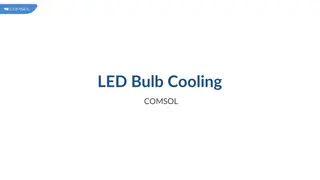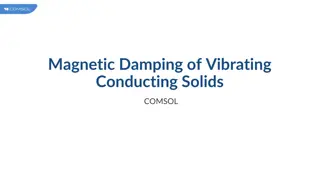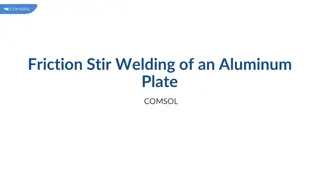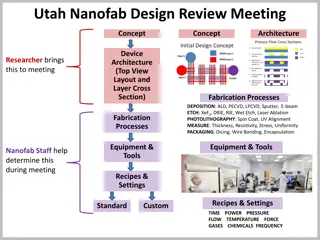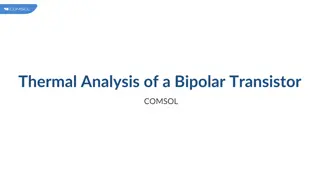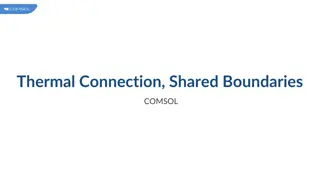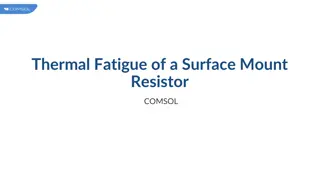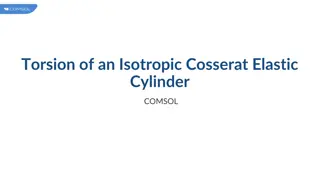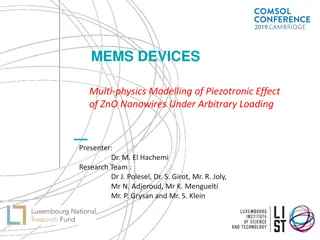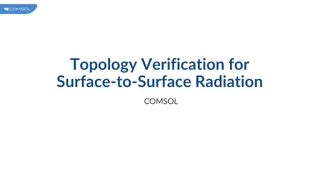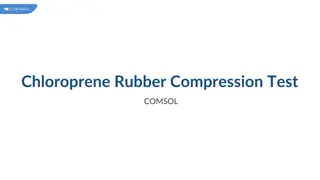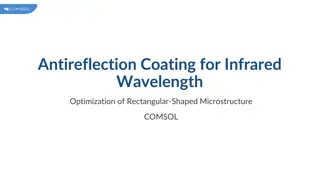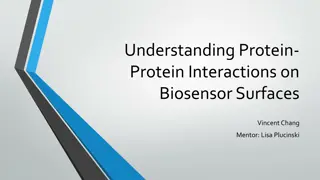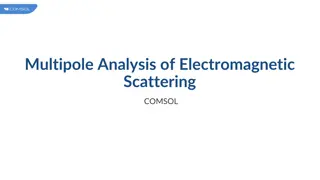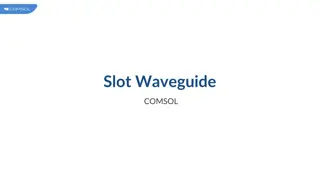LED Bulb Cooling Simulation with COMSOL
LED bulbs are preferred for their longevity and energy efficiency, but 70% of electrical power is lost as heat. This simulation using COMSOL optimizes the design to prevent overheating by considering heat sources, heat transfer, natural convection, and boundary conditions. Results show efficient coo
0 views • 7 slides
Magnetic Damping in Conducting Solids
When a conductive solid moves through a magnetic field, eddy currents are induced, creating an interaction that leads to magnetic damping. This phenomenon, known as magnetic damping of vibrating conducting solids, plays a crucial role in various applications and can be analyzed using tools like COMS
0 views • 9 slides
Ultraviolet Water Reactor Fluence Rate Calculation Model
This model demonstrates the calculation of fluence rate in an annular ultraviolet water reactor using COMSOL. The purpose is to assess radiation absorption by pathogens based on the fluence rate. Water between two concentric cylinders is considered, with the inner cylinder housing a UV lamp emitting
0 views • 9 slides
Modeling Natural Convection Cooling of a Vacuum Flask in COMSOL
This example demonstrates the modeling of natural convection cooling in a vacuum flask holding hot coffee using COMSOL. It compares two approaches to describe thermal dissipation, focusing on calculating the flask's cooling power over time. Results include temperature analysis, heat transfer coeffic
1 views • 11 slides
Friction Stir Welding of Aluminum Plate: COMSOL Simulation
Manufacturers use friction stir welding to join aluminum plates efficiently. This modern method generates frictional heat to soften the aluminum, allowing dissimilar materials to be welded together. The model in COMSOL considers heat transfer and boundary conditions to simulate the welding process,
1 views • 8 slides
Nanofabrication Design Review Meeting for Microfluidic Mixer Development
Evaluating the design, fabrication, and testing of a passive three-dimensional micromixer incorporating split and recombine structures for efficient mixing at varying flow rates. Comsol multi-physics simulations optimized channel parameters resulting in a compact mixer design with enhanced mixing ca
1 views • 15 slides
Thermal Analysis of a Bipolar Transistor Using COMSOL
This model utilizes a COMSOL simulation to analyze the thermal behavior of a bipolar transistor. The heat transfer within the device is calculated to determine the temperature distribution. Various plots, such as the Gummel plot and current gain curve, illustrate the collector and base currents as f
3 views • 11 slides
Neutralization of Proton Beam Using Charge Exchange Cell in COMSOL
In various applications, collisions of neutral particle beams with target materials play a crucial role. This process involves neutralizing high-velocity proton beams by passing them through a charge exchange cell filled with neutral gas, such as argon. The cell allows protons to capture electrons f
0 views • 17 slides
Multiphysics Coupling for Thermal Connection in COMSOL
Establishing continuity of temperatures between volume and shell domains through surfaces in a model can reduce computational costs. Learn how to set up the Thermal Connection, Layered Shell, Surfaces multiphysics coupling node in COMSOL for heat transfer simulations. Compare results between configu
0 views • 6 slides
Thermal Fatigue of a Surface Mount Resistor: A COMSOL Analysis
A COMSOL analysis is conducted on the thermal fatigue of a surface mount resistor subjected to thermal cycling. The study focuses on the solder joint, structural integrity, and life prediction using fatigue models. Various aspects of the resistor assembly, including material composition, dimensions,
0 views • 13 slides
Analysis of Torsion in Isotropic Cosserat Elastic Cylinder using COMSOL
Explore the extension of linear elastic material model to a Cosserat material, including microrotation degrees of freedom, with a focus on a cylindrical bar under pure torsion. Investigate the impact of Cosserat length scale parameter on the system response, analyzing different zones of behavior. Re
0 views • 8 slides
Piezotronic Effect Modelling of ZnO Nanowires Under Arbitrary Loading
Explore the multi-physics modelling of the piezotronic effect in ZnO nanowires under arbitrary loading. The research team led by Dr. M. El Hachemi presents innovative designs of micro-strain sensors and piezotronic cantilever sensors, with applications in fields like robotic manipulation and spectro
0 views • 11 slides
Surface-to-Surface Radiation Verification and Boundary Detection in COMSOL
Explore the verification of surface-to-surface radiation setups in COMSOL, detecting incorrect radiation configurations with nonradiating boundaries. Learn how to identify and resolve nonradiating boundaries, ensuring accurate and effective radiation simulations. Discover the importance of selecting
0 views • 10 slides
Chloroprene Rubber Compression Test Using COMSOL
Elastomers and biological materials exhibit strain rate dependent mechanical behavior and hysteresis when subjected to cyclical loads. This example demonstrates the use of the Polymer Viscoplasticity feature in the Nonlinear Structural Materials Module for modeling such phenomena using the Bergstrom
0 views • 8 slides
Ion Range Benchmark
When ions interact with solid materials at high energy levels, Single Event Effects (SEEs) can occur, impacting electronic devices in radiation environments. This study explores ion trajectories and ranges using Charged Particle Tracing in COMSOL, shedding light on potential issues in outer space el
0 views • 6 slides
Modelling induction heating of Modelling induction heating of ionic solutions using COMSOL ionic solutions using COMSOL
In this study, Dr. M.J. Taylor explores the induction heating process of ionic solutions using COMSOL. The research focuses on the interaction of alternating magnetic fields with electrically conducting materials to induce eddy currents, leading to resistive heating. The specific power transferred v
0 views • 17 slides
Optimization of Antireflection Coating for Infrared Wavelength
This study focuses on optimizing antireflection coating for infrared wavelengths on rectangular-shaped microstructures using COMSOL simulation. The geometry assumptions, modeling assumptions, transmission results, and observations are presented. The rectangular silicon microstructure enhances transm
0 views • 6 slides
Optimizing LED Bulb Cooling for Efficiency
LED bulbs are popular for their longevity and energy efficiency, but heat dissipation is a concern. This study uses COMSOL to optimize the design of an LED bulb to prevent overheating. By considering factors like materials, geometry, and heat transfer mechanisms, the model demonstrates effective coo
0 views • 6 slides
Optimizing LED Bulb Cooling for Efficiency
LED bulbs are preferred for their longevity and energy efficiency, but heat loss is a concern. Learn how geometry and material properties can be optimized using COMSOL to prevent LED bulbs from overheating and improve performance.
0 views • 6 slides
Photonic Crystal Band Gap Analysis with COMSOL Simulation
Explore the wave propagation in a photonic crystal made of GaAs pillars to uncover photonic band gaps preventing specific wavelengths from propagating. Learn about the model, electromagnetic wave analysis, and results obtained through simulation.
0 views • 10 slides
Thermal Analysis of Bipolar Transistor Simulation
Explore a COMSOL simulation model for thermal analysis of a bipolar transistor, examining temperature distribution and current characteristics. Gain insights into heat transfer and device behavior.
0 views • 14 slides
Friction Stir Welding of Aluminum Plate: COMSOL Simulation
Manufacturers use friction stir welding to join aluminum plates, resulting in pore-free weld joints without residual stresses. This model considers heat transfer during welding, with isothermal contours showing temperatures exceeding aluminum's melting point.
0 views • 5 slides
Understanding Protein-Protein Interactions on Biosensor Surfaces
Learn how to use COMSOL Multiphysics 5.1 to model reaction kinetics and surface binding in protein-protein interactions on biosensor surfaces. Explore the creation of 2D models, understanding varying concentrations of reacting species, and future goals of obtaining experimental data for biotin-strep
0 views • 9 slides
Understanding Electromigration Effects in IC Interconnect Lines
Learn about electromigration effects in IC interconnect lines, the impact of vacancies on circuit failures, governing equations, physics interfaces, boundary conditions, and implementation in COMSOL for preventing failures in integrated circuits due to vacancy accumulation.
0 views • 14 slides
Understanding Electromagnetic Scattering Multipole Analysis and Coefficients
Explore the concept of multipole analysis in electromagnetic scattering, including multipole expansion, coefficients, Mie scattering, COMSOL implementation, and associated Legendre polynomials. Learn how to extract crucial information from scattering models and optimize simulations efficiently.
0 views • 24 slides
Slot Waveguide: Research in Photonic Integrated Circuits
Explore the advancements in photonic integrated circuits with a focus on slot waveguides, a unique configuration for confining optical energy. Learn about the design, simulation, and results of slot waveguides in PICs using COMSOL simulations.
0 views • 8 slides
Improving Flux Intensity in Reflective Laser Focusing System
This study explores optimizing flux intensity in a reflective laser focusing system using COMSOL modeling. By addressing positive focal shift phenomenon, an algorithm was implemented to enhance flux density on the target, showing significant improvement. Future work involves algorithm validation for
0 views • 12 slides
